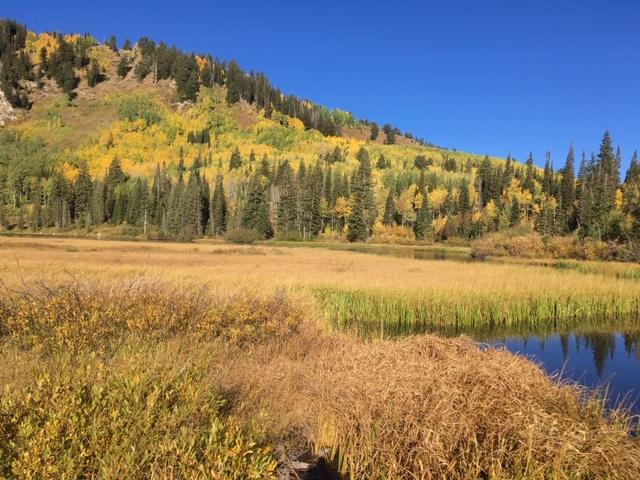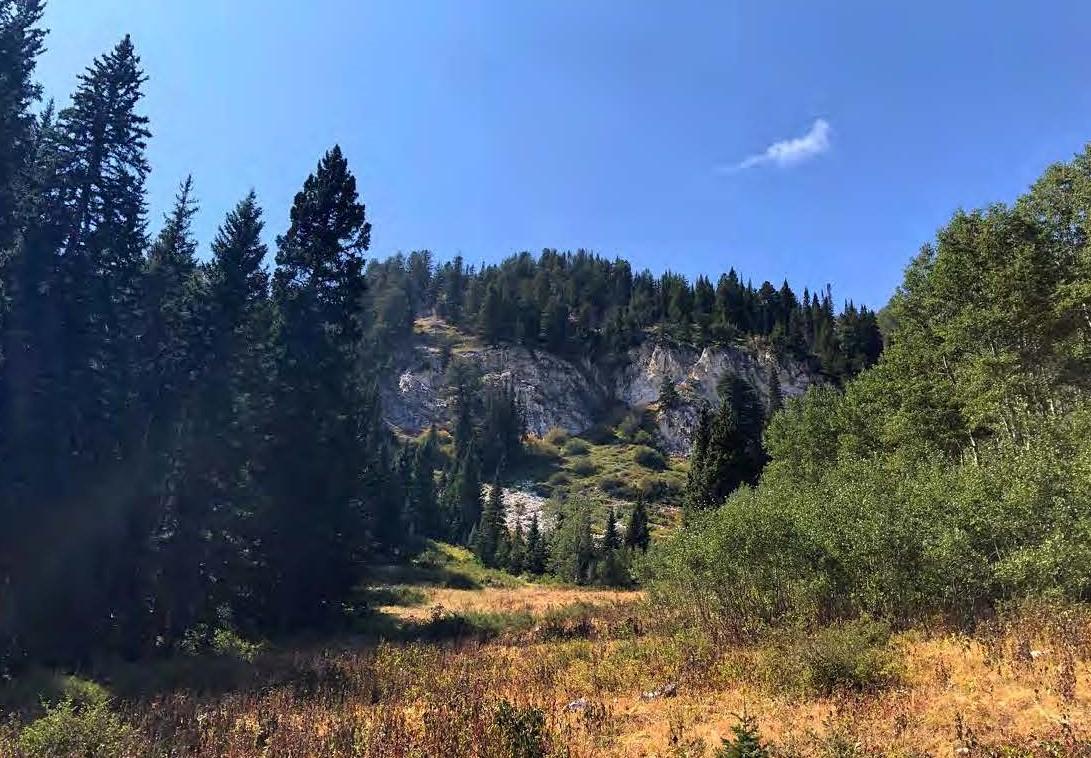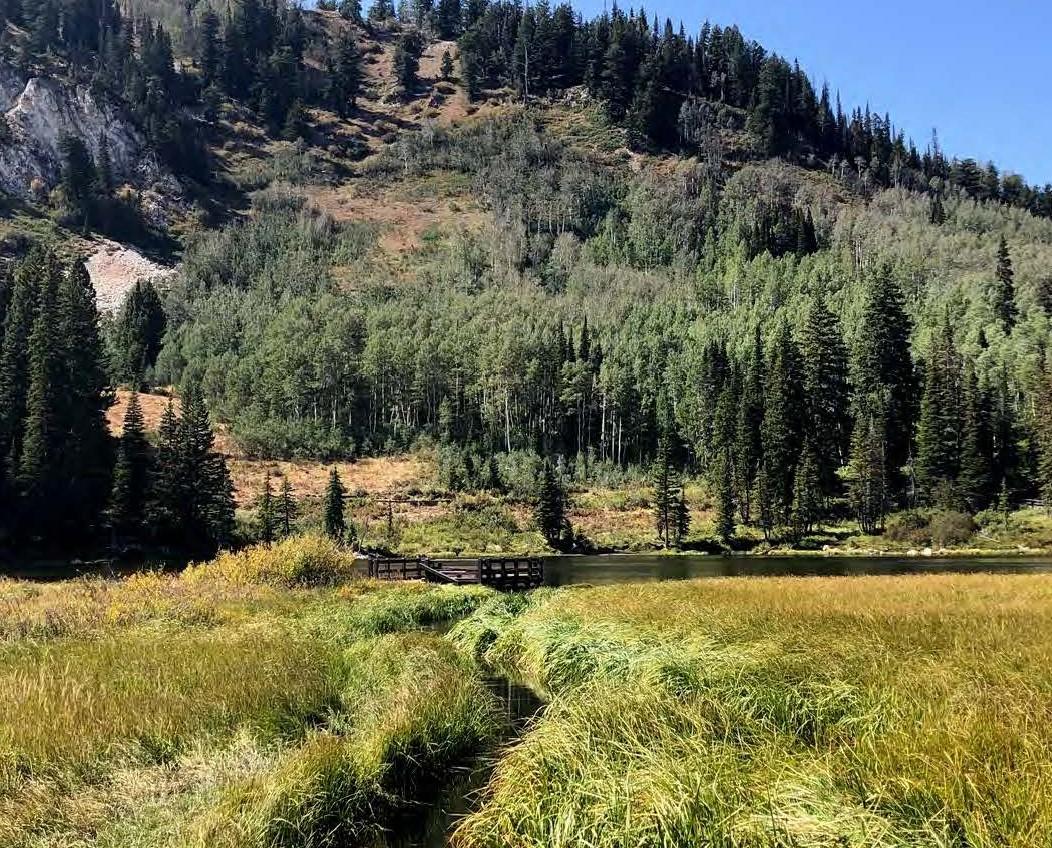Educational and Reference Resources of the Tri-Canyons
Ecology on the Trail: Habitat
Habitat
Welcome to Trails Online! In this article, we’ll narrow our scope and focus on the idea of habitats!
← Look for this Earth Icon to easily locate activities or bonus tips.We have included some supplemental activities including a module on identifying bugs that live in the water and a module on how we can use those bugs to assess the relative health of a body of water. Additionally, if you want to lead your learners in an activity to look at microhabitats, we recommend Project Learning Tree’s Forest of S.T. Shrew Activity. Directions and reading pages are in both English and Spanish.
We mentioned the 7 Leave No Trace Principles in other articles, but we wanted to bring up a few points that are more specific to Silver Lake so we can all be good stewards and respectful visitors. Please do not feed any wildlife; this includes the ducks. You may think that you are helping an animal out by feeding it, but you are likely doing more harm than good. Animals get all the food they need from the habitats where they live, and they need to be eating a natural diet – a natural diet does not include the bread from your sandwich or crackers from your snack. These foods are not nutritious for the animals and can result in malnourishment. Additionally, animals that are accustomed to people may become aggressive. Please pack out all of your food (there are trash cans and dumpsters in the parking lot) and please appreciate the wildlife in their natural state, enjoying their natural diets. Also, like last week’s location, Silver Lake is in a protected watershed so no pets and no swimming or other skin-to-water contact. It might be tempting to dip your hands or your feet into the lake, but please refrain from doing so.
Teacher Supplements
Teacher Presentation
Student Guide
Silver Lake Trail

Trail: Silver Lake Boardwalk
Directions: The Silver Lake Boardwalk trail is accessed from the Silver Lake Visitor Center located at the top of Big Cottonwood Canyon. The Center is located at 8073 Big Cottonwood Canyon Rd, Brighton, UT 84121. There is a parking lot at the Visitor Center, and while the center itself is not open, there are restrooms in the building on the south side of the parking lot. Overflow parking is available across the street or in the Brighton Resort lot. The trail begins behind the Visitor Center.
Trail Information: The Silver Lake trail is a 0.7 mile loop with minimal elevation gain. Most of the trail is along a wheelchair accessible boardwalk.
Additional Trails: For a longer hike, check out the Lake Solitude Trail which can be accessed from the junction on the northeast end of the Silver Lake Trail. This trail is 1.5 miles out and back with a 290 foot elevation gain.
Pre-Activity – Habitat
 A habitat is the specific place where a plant or an animal lives. A habitat provides four things: shelter, water, food, and space. What does your habitat look like?
A habitat is the specific place where a plant or an animal lives. A habitat provides four things: shelter, water, food, and space. What does your habitat look like?
In other articles, we talked about ecosystems, but how is an ecosystem different than a habitat? You can imagine that an ecosystem is like your neighborhood, while your house would be your habitat. In your neighborhood you interact with the living things like your neighbors, their pets, and any local wildlife. You also may interact with the grass in your yard, or the shade provided by a tree growing along the sidewalk. In your neighborhood you’re also impacted by nonliving things like the cars you should look out for when crossing the street, or the neighbor’s fence when your ball goes over it. Within the ecosystem of your neighborhood, your home would be your habitat.
Stop One – The Bridge
Topic: Wildlife
 You may recall that an ecosystem is made up of living and nonliving things. Well, some of those living (biotic) things are so important they have special names!
You may recall that an ecosystem is made up of living and nonliving things. Well, some of those living (biotic) things are so important they have special names!
Keystone Species: These species are critical to an ecosystem, without them it would drastically change. Fun Fact: a keystone is the uniquely shaped center stone of a bridge, that holds the arch together.
Indicator Species: Indicator species can be both plants or animals. Much like the name hints at, these species indicate what the health of the environment is like.
Here at Silver Lake we have both!
Beavers as a keystone species: Here at Silver Lake, the beavers serve as our keystone species. Over the years they have shaped and created the lake, wetland, and the stream. This area had all the makings for the perfect beaver habitat: Fresh water, mud, and trees. To construct their perfect habitat they make dams and lodges. Dams change and direct the flow of water, while the lodge is a specially created home that the beavers live in, complete with multiple underwater entrances (doors), a large living camber (a room), and a vent (window) to let in fresh air. Can you find the beaver lodge? This isn’t the only place you will see signs of beaver. As you make your way around the lake try and find the following: Beaver dams, chewed off trees, areas where parts of trees may have been dragged. How many signs of beaver-altered habitat do you see?
Boreal toads as an indicator species: Our indicator species is the Boreal toad! This toad is very special to Silver Lake because not only is it an indicator species it is also a rare species to see. The Boreal toads, like many amphibians, are declining in population because of habitat loss due to pollution and a deadly fungus. Amphibians have special skin that they can breathe through.Think about a sponge, it soaks up whatever liquid it is placed in, this is similar to how the toad’s skin works, soaking up any oxygen in the water. Since Silver Lake is home to the boreal toad, what does that indicate about the aquatic habitat here at Silver Lake? Is it clean and healthy or polluted? How can we tell?
Stop Two – Dock
Topic: Geology
 Do you know how canyons form? What is strong enough to carve a canyon out of solid rock? The answer to that question is water! From where you are standing on the dock, notice the shape of the canyon here. It is wide open like a bowl! The wide, U-shape of the canyon is a clue that this area was carved out by glaciers. Glaciers are large moving bodies of ice and snow. Is this entire canyon wide and U-shaped? The answer is no. When you’re driving back down the canyon, once you pass the Reynolds Flat/Donut Falls area, the canyon appears narrower and V-shaped. This tells us that this lower portion of the canyon was formed by liquid water as it flowed down the canyon.
Do you know how canyons form? What is strong enough to carve a canyon out of solid rock? The answer to that question is water! From where you are standing on the dock, notice the shape of the canyon here. It is wide open like a bowl! The wide, U-shape of the canyon is a clue that this area was carved out by glaciers. Glaciers are large moving bodies of ice and snow. Is this entire canyon wide and U-shaped? The answer is no. When you’re driving back down the canyon, once you pass the Reynolds Flat/Donut Falls area, the canyon appears narrower and V-shaped. This tells us that this lower portion of the canyon was formed by liquid water as it flowed down the canyon.
Fun fact: In this spot, it is estimated that the glacier was between 500 and 800 feet tall! If you can picture the size of a school bus, this glacier would have been the height of between 14 and 23 school buses stacked on top of each other!
As you continue around the lake, keep your eye out for a place where you can actually touch evidence of glaciers! If you need a hint, here is a picture!
The lines you see on the rock are called striations. Glaciers act like a bulldozer, and they can pick up rocks and boulders as they move. As the glacier moved, the weight of it caused those rocks and boulders to scratch into the surface of the rock you see here. Some habitats can be very small, and we call them microhabitats. Do you think that the striations on the rock provide a habitat?
(Answer: Yes! Bugs, lichens, or mosses may live in this microhabitat!)
Stop Three – Bench at Avalanche Path
Topic: Plants and Trees
 While the lake is beautiful to look at, we’re going to turn around and look at the area behind you. What do you notice about this area? Take a moment to talk about, draw, or write your observations. You’ll notice trees to your left and to your right, but what about in the middle? Where are the trees? What do you think happened here? The answer is that an avalanche came down through this spot! The avalanche destroyed the trees here and by doing so, created a habitat where herbaceous plants (plants like wildflowers and grasses) and shrubs could be very successful.
While the lake is beautiful to look at, we’re going to turn around and look at the area behind you. What do you notice about this area? Take a moment to talk about, draw, or write your observations. You’ll notice trees to your left and to your right, but what about in the middle? Where are the trees? What do you think happened here? The answer is that an avalanche came down through this spot! The avalanche destroyed the trees here and by doing so, created a habitat where herbaceous plants (plants like wildflowers and grasses) and shrubs could be very successful.
Deer love to eat these plants, so keep an eye out for them while you are at this stop!
Now let’s focus on the trees! To the left, you’ll see a coniferous forest – remember from last week that coniferous trees have needles and do not lose their leaves in the fall. And yes, the needles are the tree’s leaves! To the right, you’ll see a deciduous forest. Remember that deciduous trees, like the aspen trees you see here, lose their leaves in the fall. What do you notice about each habitat? Are there things they have in common? What about things that are different? A habitat provides food, water, shelter, and space. How does each habitat provide those things?
Stop Four – Fishing Dock
Topic: Watershed
 The lake here provides the habitat for some very special creatures that you may not even consider – bugs! These bugs spend all or part of their life cycle underwater. For example, did you know that a dragonfly lives part of its life underwater? We have a special name for these aquatic bugs, they are called benthic macroinvertebrates. “Benthic” means bottom, so where in the lake do you think they live? (Answer: They live on the bottom of the lake, in the sediment). “Macro” means that they are big enough to see them with our eyes. “Invertebrate” means that they do not have a spine. Are you an invertebrate? (No! We are vertebrates! You can feel your spine in your back and on the back of your neck.)
The lake here provides the habitat for some very special creatures that you may not even consider – bugs! These bugs spend all or part of their life cycle underwater. For example, did you know that a dragonfly lives part of its life underwater? We have a special name for these aquatic bugs, they are called benthic macroinvertebrates. “Benthic” means bottom, so where in the lake do you think they live? (Answer: They live on the bottom of the lake, in the sediment). “Macro” means that they are big enough to see them with our eyes. “Invertebrate” means that they do not have a spine. Are you an invertebrate? (No! We are vertebrates! You can feel your spine in your back and on the back of your neck.)
These bugs have many important roles – they act as nature’s recyclers by breaking down dead organic matter (plants and animals) and recycling those nutrients back into their habitat! They also can tell us how healthy the water is! Scientists know how these benthic macroinvertebrates react to different levels of pollution. Pollution can be many things such as: pesticides, chemicals, trash, viruses, and even bacteria like E-Coli that is found in animal waste. Some bugs are “pollution tolerant”, meaning they can live in places where the water is not so healthy; others are “pollution intolerant”, meaning that they cannot live in unhealthy water and can only live in water that is clean and healthy. Recall the idea of an indicator species that we talked about at Stop 1. Do you think the bugs living in the water can be considered an indicator species? To learn more about these incredible creatures, check out the activities below!
Bug Identification Activity
Bugs and Water Quality Activity
We have talked about the idea of a watershed, that it is a place where all the water drains to a common point. This watershed also provides various habitats for different species to live in – in this canyon there are lakes, wet meadows like you see here at Silver Lake, swift moving streams, stagnant pools, and more. These different features of the watershed provide many different species a place to live. Other than the bugs in the lake, what else do you think lives here? You might see some fish (we have rainbow and brown trout), mallard ducks, beaver, and if you’re lucky, boreal toads.
Stop Five – Bench
Topic: History
 If you look across the canyon, you can see something on the mountainside that is shaped like Mickey Mouse. This pile is waste left behind by the mining process, also called mine tailings. Ore is mined from the earth, then the specific mineral (gold, silver, copper, etc.) is extracted and the tailings are left behind. By the late 1800’s, there were hundreds of mine claims for gold, silver, copper, lead, and zinc here in Big Cottonwood Canyon. Do you think that mining, and leaving behind piles of mine waste, could impact habitats? Could it create habitats?
If you look across the canyon, you can see something on the mountainside that is shaped like Mickey Mouse. This pile is waste left behind by the mining process, also called mine tailings. Ore is mined from the earth, then the specific mineral (gold, silver, copper, etc.) is extracted and the tailings are left behind. By the late 1800’s, there were hundreds of mine claims for gold, silver, copper, lead, and zinc here in Big Cottonwood Canyon. Do you think that mining, and leaving behind piles of mine waste, could impact habitats? Could it create habitats?
The first statewide Pioneer Day celebration was held here at Silver Lake on July 23-24, 1857. The celebration included 2,587 people, 464 carriages and wagons, 1,028 horses and mules, and 332 oxen and cows. Can you imagine travelling up the canyon in a horse and wagon? How long do you think that would take? The festivities included brass bands, singing, dancing, athletic events, and military drills. Try to find the historical marker near the parking lot (hint: it’s on a large rock!) This area continued to be a popular place, and the use started to cause some damage to the wetlands. The boardwalk here was designed in 1976 and built in 1990, and by keeping visitors off of the wetlands the habitat has been able to restore itself to a more natural state. Many visitors ask if the lake is smaller than it once was, but it actually is the same size! However it looks a little different than many remember because of the wetland meadow that has grown.
Bonus Activity
Meet a Tree!
 Adapted from Sharing Nature with Children by Joseph Cornell
Adapted from Sharing Nature with Children by Joseph Cornell
Pick a tree along the Silver Lake Trail, or you can pick a tree in your yard or schoolyard. If you are at Silver Lake, please be sure to stay on the boardwalk and do not cross over any ropes. In the coniferous forest on the south side of the lake where there is no undergrowth vegetation, it is okay to venture off the trail a bit.
Once you’ve found your tree, close your eyes and spend some time getting to know your tree. What does the bark feel like? Can you feel the sunshine or the wind? Do you hear any nature sounds? Does the bark have a smell? Now open your eyes. Can your arms reach all the way around the tree? Do you think it is older or younger than you are? Is there anything growing on the bark? Is there any evidence of animals? How does this tree make you feel? How does this spot in the forest make you feel?
You don’t need to write down answers to these questions, but think about them and feel free to share them with others. Nature can make us feel happy, peaceful, and refreshed, and it is nice to share your feelings and observations with others!
Citation: Cornell, J. (1998). Sharing Nature with Children. Crystal City Publishers.
Post Activity
 Pick one of the animals we talked about or another animal you saw up at Silver Lake. What does its habitat look like? Does it have everything it needs (food, water, shelter, space)? How is it different than your habitat? How is it similar?
Pick one of the animals we talked about or another animal you saw up at Silver Lake. What does its habitat look like? Does it have everything it needs (food, water, shelter, space)? How is it different than your habitat? How is it similar?

